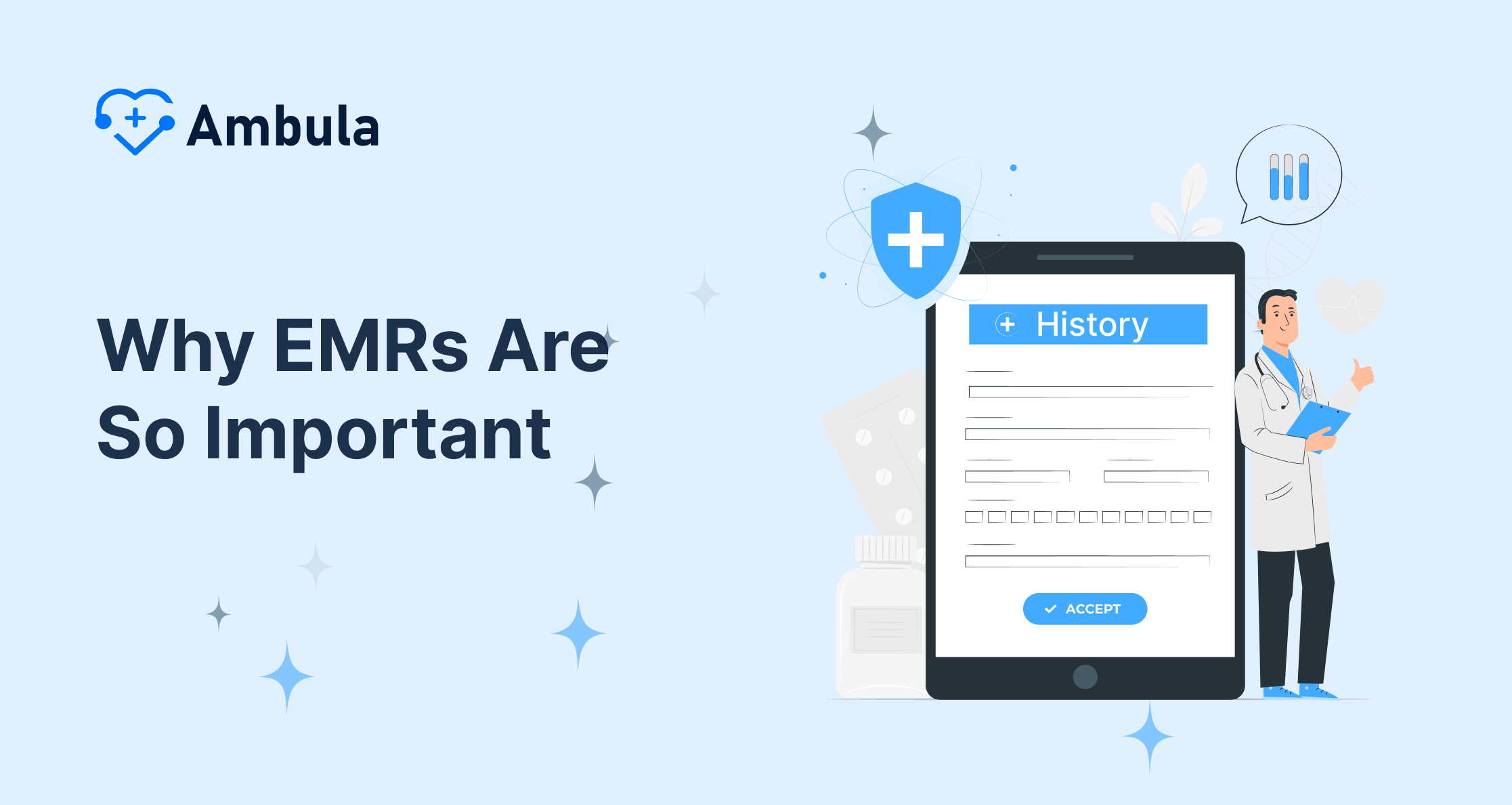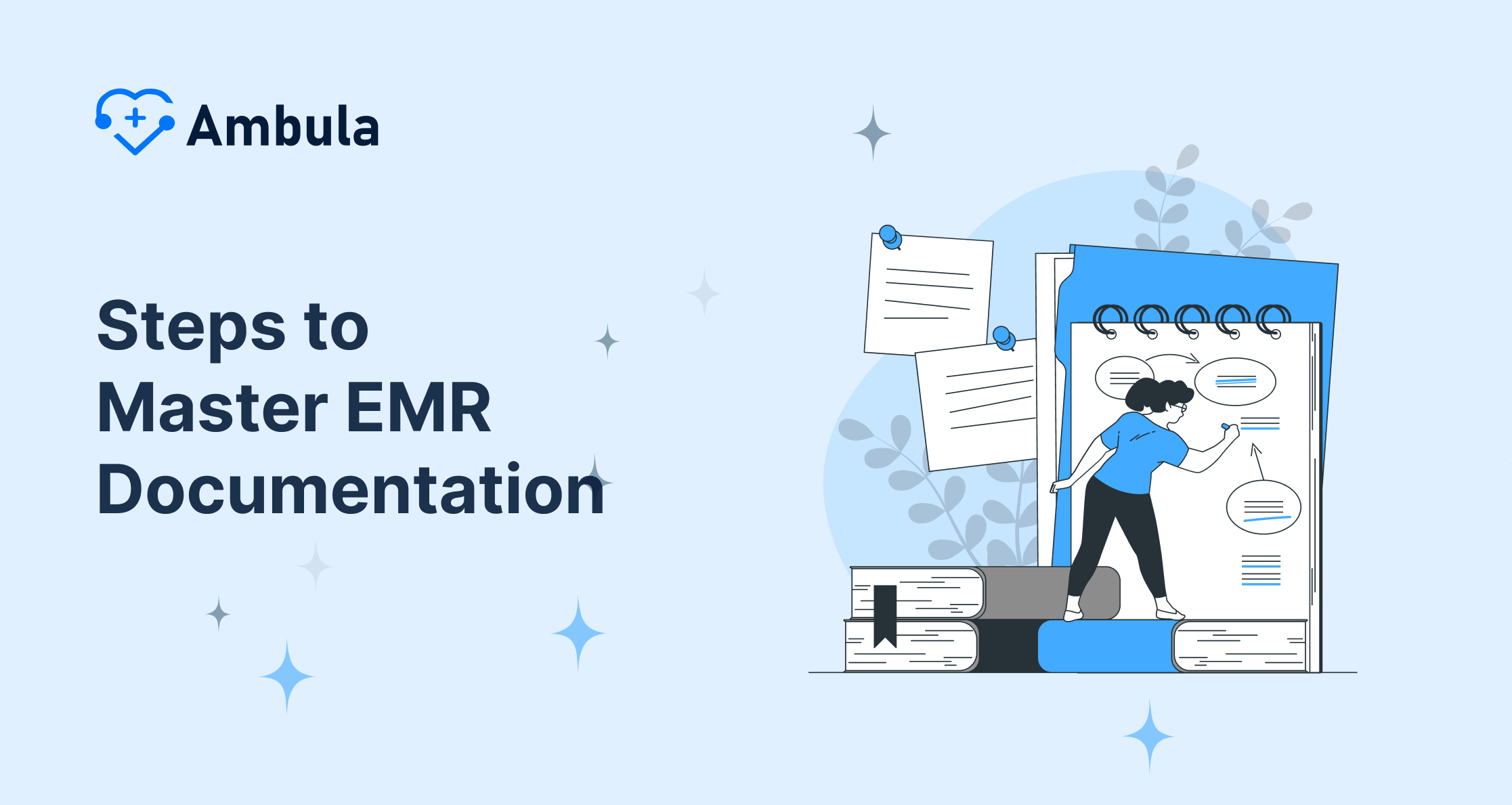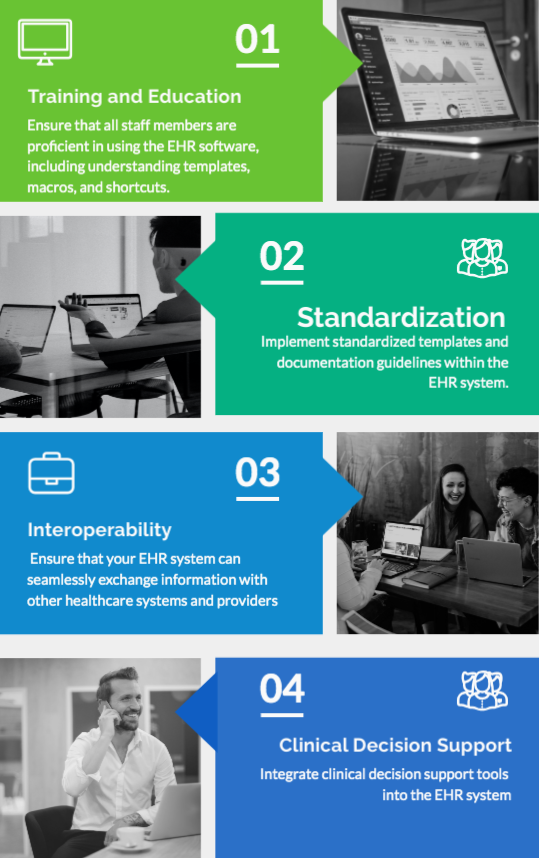In today’s ever-changing healthcare scene good record-keeping has become super important to make sure patients get great care, rules are followed, and doctors don’t burn out. EMR documentation, which stands for Electronic Medical Record documentation, is a big deal in modern healthcare. It’s a digital version of a patient’s old-school paper chart. You can’t overstate how crucial this is. It lets doctors and nurses write down and look up patient info right away, and it makes everything run smoother and keeps track of data better. As healthcare has moved from paper files to computer ones, people need to get good at EMR documentation. Getting the hang of this can make patients way safer, improve their care, and help healthcare workers do their jobs much better and faster.
This guide on getting better at EMR documentation talks about why it’s important, what steps you need to take to master it, and gives tips to make sure you’re documenting stuff well. It covers the basics of EMR in documentation, including emr serverless documentation and emr api documentation, and looks at structured data entry and coding practices. Healthcare pros will get hands-on strategies to make the most of their EMR systems. The guide also goes over ehr documentation standards, guidelines, and why it’s crucial to use electronic medical documentation in healthcare. The goal is to boost patient care quality while following HIPAA rules and making healthcare better for both doctors and patients.
Why EMRs Are So Important
How They Help Take Care of Patients
EMRs make patient care way better. They give doctors and nurses a full picture of a patient’s health history, which helps them make smart choices about treatment. Good record-keeping keeps care smooth, letting different doctors see the same information. This is super helpful when a patient sees lots of specialists so everyone knows what’s going on. Plus, EMR systems can track how a patient’s health changes over time. This helps to prevent problems and keep an eye on long-term health issues.
Legal and Compliance Requirements
EMR documentation is both a medical need and a legal must. Clear and detailed records help defend against malpractice claims by showing exactly what care doctors gave. These electronic records can also be proof in court cases. EMRs have to follow many rules, like those about privacy and security under laws such as HIPAA. Following these rules means docs meet the right standards for billing and checks. This helps avoid legal trouble and lets doctors get paid.
Impact on Healthcare Efficiency
EMRs make healthcare easier by cutting down on paperwork and helping medical practices work better. They help with value-based care by tracking important numbers that the government and insurance companies want. This makes care better and speeds up getting paid by processing claims faster and making fewer mistakes. Doctors and nurses can look at and update patient files, which means less office work and more time to take care of patients 1 2. Also, EMR systems have tools to help make better choices about treatment and lower the chance of bad drug reactions.
Steps to Master EMR Documentation
Creating a User-Friendly Environment
To master EMR documentation, you need to improve the EHR interface design to cut down on too many mouse clicks, logins, and screen interactions. These can make doctors tired. A simple interface helps departments work together and lets patients access their info . Keeping the EHR user interface simple helps save money when building it. It also makes sure patients and doctors can use the system without trouble. They can get alerts about mistakes in prescriptions or notes. Also, adding ways for users to undo things can help fix accidental actions giving a safety net to correct mistakes.
Training and Continuous Education
Keeping up with EMR documentation skills is super important for healthcare workers. They need to stay on top of things by taking classes and stuff. To keep their certification, they have to do 16 hours of extra learning through this program called the EMR National Continued Competency Program (NCCP). This program has different parts – national local/state, and individual stuff. All the learning has to be about taking care of EMS patients. The cool thing is that healthcare people can choose to do online classes or go to in-person ones to get their hours. This way, they’re always learning about new ways to do EMR documentation and using the latest tech.
Using Help Tools and Resources
Using support tools and resources can boost how you do EMR paperwork. You can save time by using ready-made forms for regular check-ups, physicals, and specific exam parts. This cuts down on typing the same stuff over and over. Learning to turn part of a note into a template or add smart phrases can save time and make your notes more accurate. Also, being good at typing or having someone else write for you lets doctors make electronic notes as fast as handwritten ones, without needing extra time to dictate after seeing a patient. For trickier cases, online surveys can gather info quickly, helping doctors update EMR records.
Healthcare providers can get good at EMR documentation by doing a few key things. First, they need to make sure the system is easy to use. Second, they should keep learning new stuff about it. And third, they gotta use the right tools and help when they need it. If they do all this, they’ll be able to take better care of patients and make things run smoother in their practice.
Best Practices for EMR Documentation
Accurate Data Entry Techniques
Accurate data entry has an impact on keeping Electronic Medical Records (EMRs) reliable. It helps doctors get good info to diagnose and treat patients well. Some key ways to do this include using auto-features like predictive text and auto-complete. These cut down on typing by hand and save time. Also, voice recognition software can speed things up for long notes. It’s also important to make workflows smoother by setting up data entry in the right order and putting related fields together to cut out extra steps.
Review and Validation Procedures
Concurrent Clinical Documentation Integrity (CDI) review has a big impact on getting the patient’s condition right during their healthcare journey. It checks if the documented conditions have clinical support. This process is key to point out any differences in the record, which helps keep the documentation accurate and complete. Updating and double-checking EMR software often makes sure reports match current medical rules and practices, which makes patient care better.
How to Use Copy/Paste Functions Well
Copy/paste in EMRs can save lots of time, but it’s gotta be used to avoid mistakes. If old or wrong info gets copied over, it can cause medical mess-ups. That’s why it’s super important to set up rules and steps to make sure this feature is used . Hospitals and clinics should come up with policies to put limits on copy-pasting and teach their staff how to use these tools the right way. They should also use checking systems to keep an eye on things and make sure copy-pasting is done and 10.
Cool Tricks to Speed Up EMR Documentation
Using Virtual Helpers and Assistants
Virtual scribes and assistants have a big impact on EMR documentation productivity. Companies like Augmedix and ScribeEMR offer virtual scribes who do real-time documentation. This lets doctors pay full attention to patient interaction. These remote helpers can boost patient access by 25-50%. This means doctors can see more patients, which adds a lot to yearly income. Also, AI-powered voice assistants cut down the time doctors spend writing stuff. They make the entry process automatic. This can lead to an 85% drop in burnout and a 72% reduction in time spent on paperwork.
Making Workflow Processes Better
To make EMR documentation faster, it’s super important to improve how work gets done. Looking at workflows helps spot problems and find ways to make things better in healthcare systems. When healthcare groups get the people who actually use the system involved in making it better, the changes are more likely to work and help out. This leads to better patient care teamwork and less time wasted. The Plan-Do-Study-Act (PDSA) method works well to test and tweak processes bit by bit. This makes sure each step is as quick and good as it can be.
Using Tech to Do Stuff
Using high-tech stuff can really speed up EMR paperwork. AI that makes things has a big impact on EMR systems. It creates detailed notes about patients by looking at medical info and spotting patterns like symptoms and what’s wrong with people. This makes paperwork faster and more accurate, and it takes some work off doctors so they can spend more time with patients. Also, things like e-prescribing and sharing health info between different places work well with EMR systems to make care happen faster and keep prescriptions and patient info more accurate.
If healthcare people use these cool tips, they can make EMR paperwork way better and faster, which means patients get better care and everything runs smoother.
Conclusion
This guide has looked into good ways to do EMR documentation. It shows how these processes have a big impact on making patient care better meeting legal rules, and helping healthcare work smoother. We’ve dug into the key steps to get good at EMR documentation. These include setting up an easy-to-use workspace, keeping up with new learning, and using smart helper tools. We’ve pointed out real things healthcare pros can do to use EMR systems better. We also talked about what works best and some clever tips. These range from putting in correct info and being careful when copying and pasting, to trying out new tech like virtual helpers and automating some tasks. All this shines a light on ways to make documentation faster and help patients more.
Learning how to do EMR documentation right is super important. It’s not just about making things run smoother – it helps doctors take better care of patients and makes the whole healthcare experience nicer for everyone. As healthcare keeps changing, using these tips and tricks in everyday work will be key for healthcare providers who want to keep up with all the crazy stuff in modern healthcare. This guide isn’t just a how-to for awesome EMR documentation – it’s also a kick in the pants to create a healthcare system that works better, does more, and puts patients first. Looking ahead, it’s crucial for healthcare pros to keep tweaking how they document stuff as new tech pops up and rules change. This will help build a future where tech and caring for people go hand in hand.
FAQs
1. What are the necessary steps for effective medical documentation?
To document medical stuff well, you gotta do these things:
- Put the date, time, and your signature on everything you write.
- Write your name and job at the top, plus anyone else who helped out.
- Write down what happened right after it happens, or as soon as you can.
- Make sure people can read your handwriting.
- Try to include all the details, get things right, and don’t let your feelings get in the way.
- Keep it professional when you’re writing.
2. What are the three key components of documentation in an Electronic Health Record (EHR)?
When you’re putting stuff in an EHR, you need to focus on three main things:
- Objective: Doctors write down physical exams and check vital signs.
- Assessment: They sum up what’s wrong sometimes listing more than one problem.
- Plan: They decide how to treat the patient maybe with medicine, procedures, or therapy.
3. What’s the difference between a medical record, an EMR, and an EHR?
They’re mostly different in who can see them and how they’re used. one doctor can look at an EMR, and it has info from just that doctor. But an EHR? Lots of doctors and hospitals can see it, so they can share patient info better.
4. What’s the main difference between an EMR and an EHR?
An EHR has a bigger impact on healthcare records than an EMR. Multiple providers keep and use EHRs, which makes them more complete. On the other hand, one provider manages an EMR. They use it to figure out what’s wrong and treat patients in their own office.
References
[1] – https://www.scphealth.com/providers/blog/think-with-your-ink-4-reasons-why-proper-medical-record-documentation-is-vital[2] – https://www.ncbi.nlm.nih.gov/pmc/articles/PMC8738966/[3] – https://www.compliance.cuimc.columbia.edu/billing-compliance/billing-compliance-manual/documentation-emr-guidelines[4] – https://www.mosmedicalrecordreview.com/blog/legal-issues-that-emrs-can-create/
[/fusion_toggle][/fusion_accordion]







